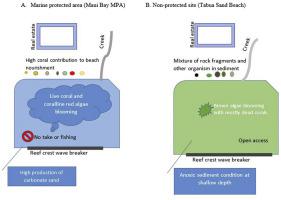当前位置:
X-MOL 学术
›
Ocean Coast Manage.
›
论文详情
Our official English website, www.x-mol.net, welcomes your feedback! (Note: you will need to create a separate account there.)
Carbonate sediments from Maui bay (coral coast, Fiji) reflect importance of coral reef conservation
Ocean & Coastal Management ( IF 4.6 ) Pub Date : 2020-12-01 , DOI: 10.1016/j.ocecoaman.2020.105381 Ronick S. Shadrack , Susanne Pohler , Leo X.C. Dutra , Krishna Kumar Kotra
Ocean & Coastal Management ( IF 4.6 ) Pub Date : 2020-12-01 , DOI: 10.1016/j.ocecoaman.2020.105381 Ronick S. Shadrack , Susanne Pohler , Leo X.C. Dutra , Krishna Kumar Kotra

|
Abstract This study describes the origin and characteristics of unconsolidated coral reef sediments from Maui Bay (Coral Coast, Viti Levu Island, Fiji), a site declared under customary law as Marine Protected Area (MPA) by traditional owners in Tagaqe village since the year 2000. Sediment samples were collected from five transect lines and analysed in the laboratory through drying process and sieving to fractional sizes. The results show that sediments from Maui Bay MPA are composed of very coarse sand (mean sediment size of 1.5 mm) mostly constituted of coral fragments (e.g. Seriatopora spp. and Porites spp.; coral fragments in ≥50% of grains) followed by other smaller particles of calcareous organisms (foraminifera and molluscs, 10–36% of the grains). As expected, siliciclastic sediments are most abundant near the mouth of a creek which brings in sediments from the mountainous hinterland. A comparison of Maui Bay with a non-protected fringing reef with very similar bathymetry at Tabua Sands (qualitative data) along the Coral Coast shows that the non-protected site is rich in brown algae with mostly dead corals. The darkish colour and smell of rotten eggs emanating from sediments collected at Tabua Sands suggests anoxic conditions at shallow sediment depth. This is in contrast to the clean white sediments encountered at Maui Bay indicating healthier coral reefs, which shows the importance and success of protection measures implemented here.
中文翻译:

毛伊湾(斐济珊瑚海岸)的碳酸盐沉积物反映了珊瑚礁保护的重要性
摘要 本研究描述了毛伊湾(斐济维提岛珊瑚海岸)的松散珊瑚礁沉积物的起源和特征,该地点自 2000 年以来根据习惯法被 Tagaqe 村的传统所有者宣布为海洋保护区(MPA)。 . 沉积物样品从 5 条样线中采集,并在实验室中通过干燥过程和筛分至小尺寸进行分析。结果表明,茂宜湾海洋保护区的沉积物由非常粗的沙子组成(平均沉积物尺寸为 1.5 毫米),主要由珊瑚碎片(例如 Seriatopora spp. 和 Porites spp.;珊瑚碎片在 ≥ 50% 的颗粒中组成),其次是其他较小的钙质生物颗粒(有孔虫和软体动物,占谷物的 10-36%)。正如预期的那样,硅质碎屑沉积物在一条小溪口附近最为丰富,这条小溪从山区腹地带入沉积物。毛伊湾与珊瑚海岸 Tabua Sands(定性数据)水深测量非常相似的未受保护的边缘礁的比较表明,未受保护的地点富含褐藻,其中大部分是死珊瑚。从 Tabua Sands 收集的沉积物中散发出的深色和臭鸡蛋味表明浅层沉积物处于缺氧状态。这与茂宜湾遇到的干净的白色沉积物形成对比,表明珊瑚礁更健康,这表明这里实施的保护措施的重要性和成功。毛伊湾与珊瑚海岸 Tabua Sands(定性数据)水深测量非常相似的未受保护的边缘礁的比较表明,未受保护的地点富含褐藻,其中大部分是死珊瑚。从 Tabua Sands 收集的沉积物中散发出的深色和臭鸡蛋味表明浅层沉积物处于缺氧状态。这与茂宜湾遇到的干净的白色沉积物形成对比,表明珊瑚礁更健康,这表明这里实施的保护措施的重要性和成功。毛伊湾与珊瑚海岸 Tabua Sands(定性数据)水深测量非常相似的未受保护的边缘礁的比较表明,未受保护的地点富含褐藻,其中大部分是死珊瑚。从 Tabua Sands 收集的沉积物中散发出的深色和臭鸡蛋味表明浅层沉积物处于缺氧状态。这与茂宜湾遇到的干净的白色沉积物形成对比,表明珊瑚礁更健康,这表明这里实施的保护措施的重要性和成功。
更新日期:2020-12-01
中文翻译:

毛伊湾(斐济珊瑚海岸)的碳酸盐沉积物反映了珊瑚礁保护的重要性
摘要 本研究描述了毛伊湾(斐济维提岛珊瑚海岸)的松散珊瑚礁沉积物的起源和特征,该地点自 2000 年以来根据习惯法被 Tagaqe 村的传统所有者宣布为海洋保护区(MPA)。 . 沉积物样品从 5 条样线中采集,并在实验室中通过干燥过程和筛分至小尺寸进行分析。结果表明,茂宜湾海洋保护区的沉积物由非常粗的沙子组成(平均沉积物尺寸为 1.5 毫米),主要由珊瑚碎片(例如 Seriatopora spp. 和 Porites spp.;珊瑚碎片在 ≥ 50% 的颗粒中组成),其次是其他较小的钙质生物颗粒(有孔虫和软体动物,占谷物的 10-36%)。正如预期的那样,硅质碎屑沉积物在一条小溪口附近最为丰富,这条小溪从山区腹地带入沉积物。毛伊湾与珊瑚海岸 Tabua Sands(定性数据)水深测量非常相似的未受保护的边缘礁的比较表明,未受保护的地点富含褐藻,其中大部分是死珊瑚。从 Tabua Sands 收集的沉积物中散发出的深色和臭鸡蛋味表明浅层沉积物处于缺氧状态。这与茂宜湾遇到的干净的白色沉积物形成对比,表明珊瑚礁更健康,这表明这里实施的保护措施的重要性和成功。毛伊湾与珊瑚海岸 Tabua Sands(定性数据)水深测量非常相似的未受保护的边缘礁的比较表明,未受保护的地点富含褐藻,其中大部分是死珊瑚。从 Tabua Sands 收集的沉积物中散发出的深色和臭鸡蛋味表明浅层沉积物处于缺氧状态。这与茂宜湾遇到的干净的白色沉积物形成对比,表明珊瑚礁更健康,这表明这里实施的保护措施的重要性和成功。毛伊湾与珊瑚海岸 Tabua Sands(定性数据)水深测量非常相似的未受保护的边缘礁的比较表明,未受保护的地点富含褐藻,其中大部分是死珊瑚。从 Tabua Sands 收集的沉积物中散发出的深色和臭鸡蛋味表明浅层沉积物处于缺氧状态。这与茂宜湾遇到的干净的白色沉积物形成对比,表明珊瑚礁更健康,这表明这里实施的保护措施的重要性和成功。



























 京公网安备 11010802027423号
京公网安备 11010802027423号